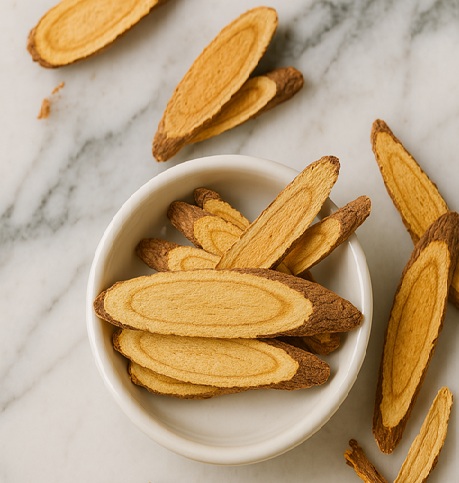Chinese Licorice Root Herb

Chinese Licorice Root (Gan Cao): A Harmonizing Herb for Digestion, Cough, and Stress Relief
Introduction
Chinese licorice root, known as Gan Cao (甘草) in Traditional Chinese Medicine (TCM), is one of the most important and widely used herbs in Chinese herbal practice. Revered for its sweet flavor and harmonizing properties, Gan Cao has been used for over 2,000 years to support digestion, relieve cough, ease pain, and balance herbal formulas. Today, it remains a key ingredient in both traditional and modern herbal remedies, valued for its versatility and effectiveness.
What Is Chinese Licorice Root?
Chinese licorice root comes from the Glycyrrhiza uralensis plant, a perennial native to Asia. In TCM, it is considered a sweet, neutral herb that enters all twelve meridians—making it a universal harmonizer. It is used to tonify the Spleen, moisten the Lungs, soothe spasms, and detoxify other herbs. The root is typically sliced and dried, and used in teas, decoctions, soups, and herbal formulas.
Health Benefits of Chinese Licorice Root
1. Supports Digestion and Strengthens Qi
Gan Cao tonifies the Spleen and Stomach, improving energy and digestion. It’s commonly used to relieve bloating, fatigue, or poor appetite, especially when combined with other qi-tonifying herbs.
2. Soothes the Lungs and Relieves Cough
Licorice root moistens the Lungs and helps reduce coughs, wheezing, and sore throat. It is frequently found in formulas for both dry and productive coughs.
3. Reduces Pain and Muscle Spasms
Gan Cao is used to ease spasms and tension in the muscles, abdomen, and chest. It’s often included in pain-relieving herbal formulas.
4. Detoxifies and Harmonizes Other Herbs
One of licorice’s unique roles in TCM is its ability to moderate harsh or toxic herbs in formulas. It enhances the effects of other ingredients while reducing their potential side effects.
5. Acts as an Adaptogen
Chinese licorice also has adaptogenic properties, helping the body manage physical and emotional stress. It supports adrenal health and balances cortisol levels.
How to Use Chinese Licorice Root
In Soups
Gan Cao is sometimes added to slow-cooked broths or herbal soups to harmonize other ingredients and support digestion.
Use 3–6 grams of sliced dried root per pot.
Simmer for 1–2 hours with ingredients like ginger, goji berries, or codonopsis.
In Tea or Decoctions
Chinese licorice is commonly brewed alone or with herbs like ginger, mint, or ginseng.
Use 1–2 teaspoons of root per cup of water.
Simmer for 20–30 minutes to bring out its sweet and soothing properties.
In Powder or Capsule Form
For convenience, Gan Cao is available in powder or capsule form. Choose reputable sources, especially if taking it regularly or in high doses.
Where to Buy Chinese Licorice Root
You can purchase Chinese licorice root in:
-
Chinese herbal stores
-
Health food shops
-
Online retailers like Amazon, iHerb, or specialty TCM websites
Look for:
-
Sliced or whole dried root (for teas and soups)
-
Licorice granules or powders
-
Standardized extracts (for precise dosage and clinical use)
Are There Any Side Effects?
Gan Cao is safe for most people when used in moderate amounts. However, large or prolonged doses can raise blood pressure, cause water retention, or affect potassium levels due to its glycyrrhizin content. Those with hypertension, heart issues, or kidney disease should consult a healthcare provider. Deglycyrrhizinated licorice (DGL) is an alternative for safer long-term use.
Conclusion
Chinese licorice root is a sweet, balancing herb that enhances digestion, soothes the lungs, and harmonizes the effects of other herbs. Whether brewed in tea, added to soups, or taken in supplement form, Gan Cao offers a wide range of benefits and is one of the most adaptable herbs in Chinese medicine.
FAQs
Q: Can I take Chinese licorice root every day?
A: In small, food-based doses or short-term use, yes. Long-term or high-dose use should be supervised by a healthcare provider, especially if you have high blood pressure.
Q: What does Chinese licorice taste like?
A: It has a naturally sweet, earthy taste that blends well with other herbs in teas and soups.
Q: Is Chinese licorice root safe for children?
A: Yes, in low doses and food-like preparations, it is often used to soothe coughs and stomach issues in children. Always consult a pediatric herbalist or doctor first.

